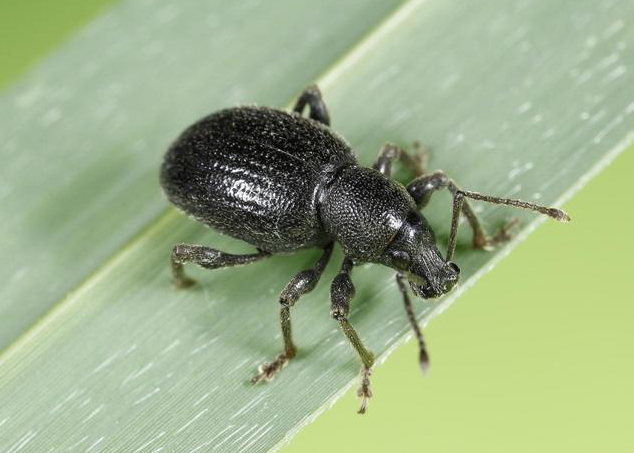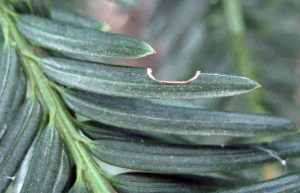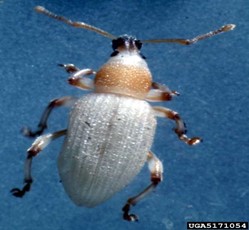Black Vine Weevils
By Catherine Goss, Fairfax Master Gardener
 The black vine weevil, Otiorhynchus sulcatus, can be a serious pest in eastern suburban landscapes. First reported in Connecticut in 1910, this European native is one of the most destructive species of root weevils and a serious pest in your garden. This tiny 0.25-inch (6 mm) insect can be found feeding on a variety of evergreen, deciduous and herbaceous plants. You can see damage on yew, cherry laurel, euonymus and rhododendron, but damage can also occur on over 100 species of annual and perennial herbaceous plants. The black vine weevil can be found in gardens, nurseries and greenhouses. The insect’s preference for yew (Taxus spp.) has earned it the nickname taxus weevil.
The black vine weevil, Otiorhynchus sulcatus, can be a serious pest in eastern suburban landscapes. First reported in Connecticut in 1910, this European native is one of the most destructive species of root weevils and a serious pest in your garden. This tiny 0.25-inch (6 mm) insect can be found feeding on a variety of evergreen, deciduous and herbaceous plants. You can see damage on yew, cherry laurel, euonymus and rhododendron, but damage can also occur on over 100 species of annual and perennial herbaceous plants. The black vine weevil can be found in gardens, nurseries and greenhouses. The insect’s preference for yew (Taxus spp.) has earned it the nickname taxus weevil.

Typical damage on rhododendron
On plants, adult black vine weevils chew irregular notches along the leaf margins at night. The damage is always on leaf margins and never in the center of the leaf. The notching rarely impacts the health of the plant. However, seeing this type of leaf damage can be an indication of larvae in the soil. The larvae overwinter in the soil and feed on plant roots. The damage to the roots can cause a plant to wilt, turn brown and die. These visual clues can often result in a mistaken diagnosis for a plant disease versus insect damage.
Adult weevils emerge from the soil in late spring and feed on leaves. They only eat at night and drop to the ground if disturbed. After gorging for 21 to 28 days, the adults return to the soil to lay their eggs and start the cycle all over. There are no known male weevils, so the females reproduce in a process called parthenogenesis, a form of asexual reproduction. Only one generation occurs per year. The adults lay up to 500 eggs in the soil at the base of the plant during a two-to-three-week period. The larvae hatch in 10 to 14 days.

Damage on Taxus
The larvae or grub stage is very damaging to plants. Initially, the grubs feed on the small tender roots at the base of a plant. As temperatures drop, they move deeper into the soil and feed on the bark of large roots or stems. The feeding on the roots and even girdling the lower stems causes irreparable harm to the plant by disrupting the flow of nutrients and water. Container grown plants might be able to survive the larvae feeding, but once a plant is in the landscape, root damage may result in the death of the plant.
Adult weevils are black but can be a lighter gray when they first emerge from the ground. The larvae are white and C-shaped, with reddish brown heads. The weevils have wings, but they cannot fly since their wing covers are fused together. Their front wings are covered with tiny concave areas and small patches of short golden hairs.

Newly emerged female black vine weevil adult
There are multifold controls for black vine weevils. First, check to make sure plants are pest free when purchasing them from a nursery. Next, look for adult weevils on plants in May and June when they are active. Monitor plants in the yard by examining leaves for damage on broad leaf plants. On yews, look for signs of damage near the main trunk or stems in addition to their leaves. In June and July, reduce excess moisture at the base of plants when adults are laying eggs.
For a nonchemical control, apply beneficial nematodes in the soil once soil temperatures are above 50 degrees. Two nematode species recommended for control are Herterorhabditis bacteriophora and Heterorhabditis megidis, both commercially available. Consult the current addition of the Virginia Integrated Pest Management (IPM) guidelines before applying systemic insecticides if you feel chemical controls are necessary.
References
• Black Vine Weevils, Advice, Tips and Resources, Missouri Botanical Garden
• Black Vine Weevil, Eric Day, Olivia C. McCraw and Theresa A. Dellinger, Virginia Cooperative Extension
• Home Invaders I, The Lesser of Two Weevils?, Michael J. Raupp, Bug of The Week,
University of Maryland Extension
• Black Vine Weevil, Gregory A. Hoover, Sr., Penn State Extension
• Weevils, Eric R. Day and Alejandro Del-Pozo, Section 4, Home Ornamentals, Insects of Trees, Shrubs,
Annuals and Perennials, 2021 Pest Management Guide